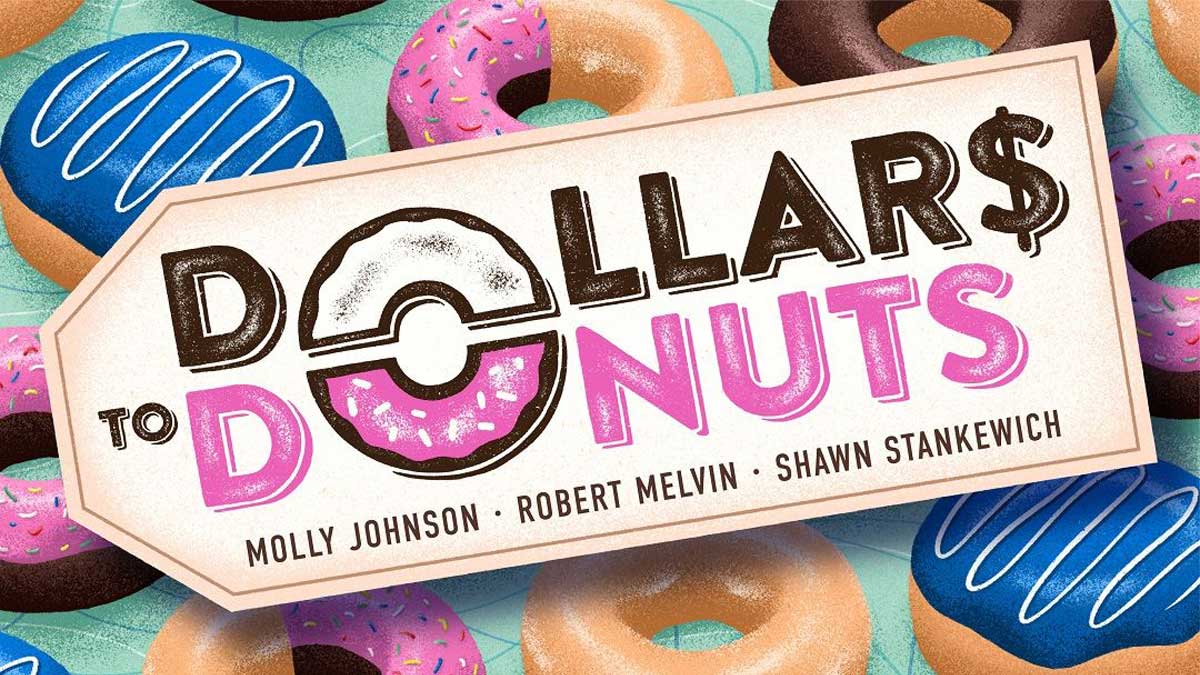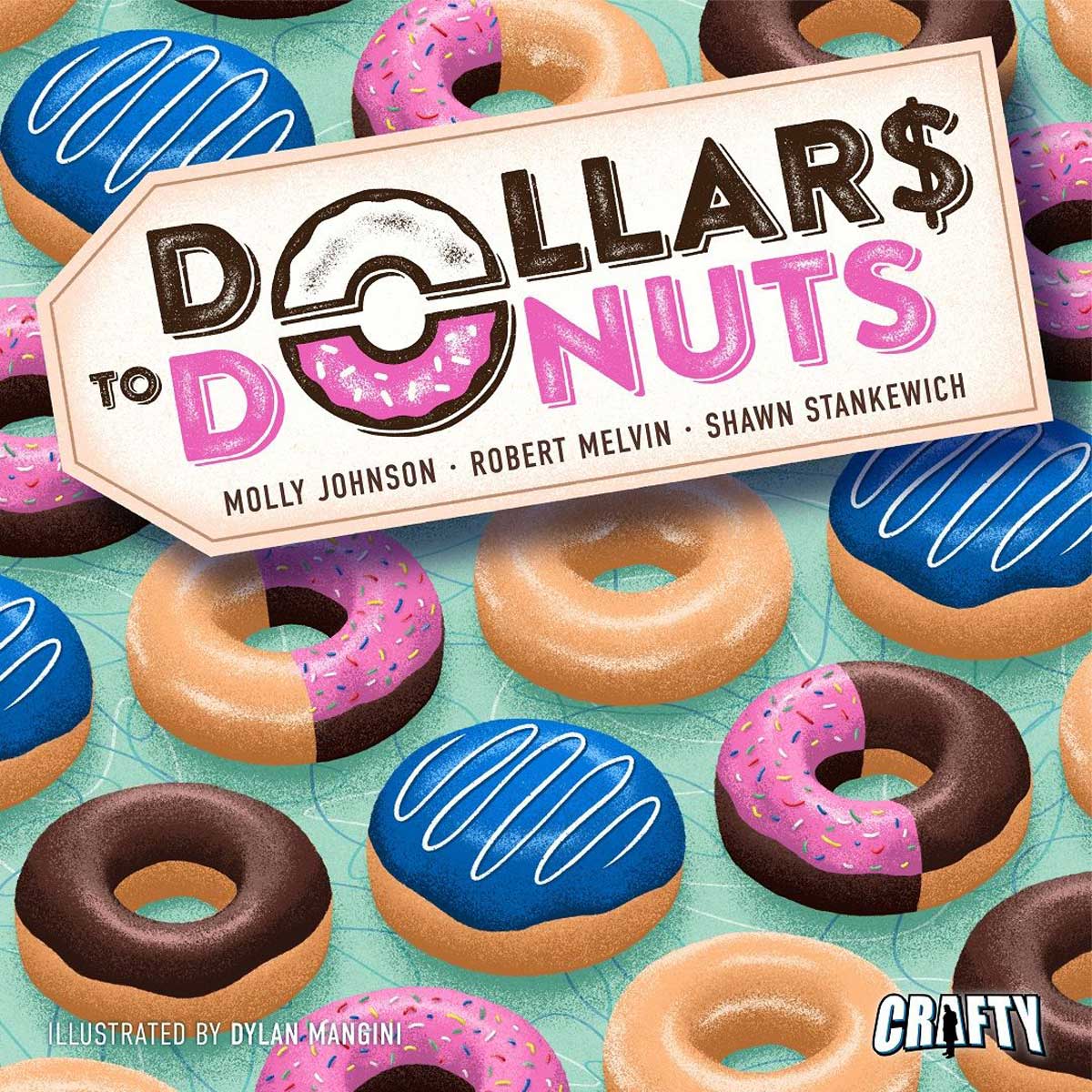What Is Dollars to Donuts?
Dollars to Donuts is a tile-laying game for 1 to 4 players, ages 8 and up, and takes about 30–45 minutes to play. It’s currently seeking funding on Kickstarter, with a pledge level of $29 (plus shipping) for a copy of the game. The game requires some spatial reasoning for the tile-placement, and is appropriate for both kids and adults, especially those who enjoy puzzles.
Dollars to Donuts was designed by the Flatout Games team (Molly Johnson, Robert Melvin, and Shawn Stankewich), published by Crafty Games, and illustrated by Dylan Mangini.
New to Kickstarter? Check out our crowdfunding primer.
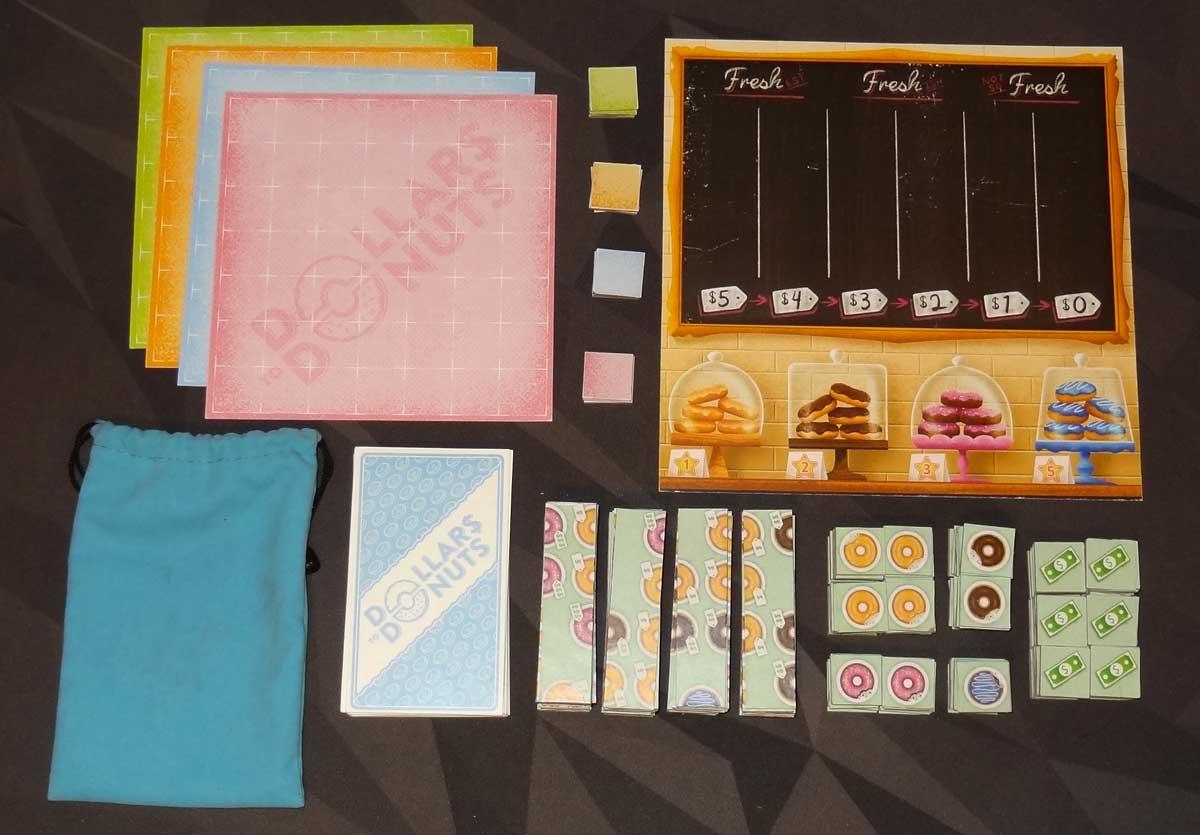
Dollars to Donuts Components
Note: My review is based on a prototype copy, so it is subject to change and may not reflect final component quality. The victory tokens will be round donuts rather than the square tokens you see in my photos. The final components will depend on the funding level of the Kickstarter campaign.
Here’s what comes in the box:
- 4 Player mats
- 16 Starter tiles
- Specials board
- 24 Customer cards
- 61 Donut tiles
- 60 Dollar tiles
- Cloth bag
- 100 Victory tokens (donuts)
- 42 Plain
- 28 Chocolate Glazed
- 18 Deluxe Sprinkle
- 12 Jelly Filled
Kickstarter backers will also receive 3 promo customer cards (featuring Crafty Games personalities).

The artwork for the game is by Dylan Mangini, who also illustrated Point Salad, and it’s pretty delightful. The specials board is made to look like a chalkboard menu over a display of donuts. There’s a wide variety of customers, which is nice to see, and each one has a little quote at the bottom expressing their love of donuts. The customers come from three different neighborhoods, each with a different background color and logo.
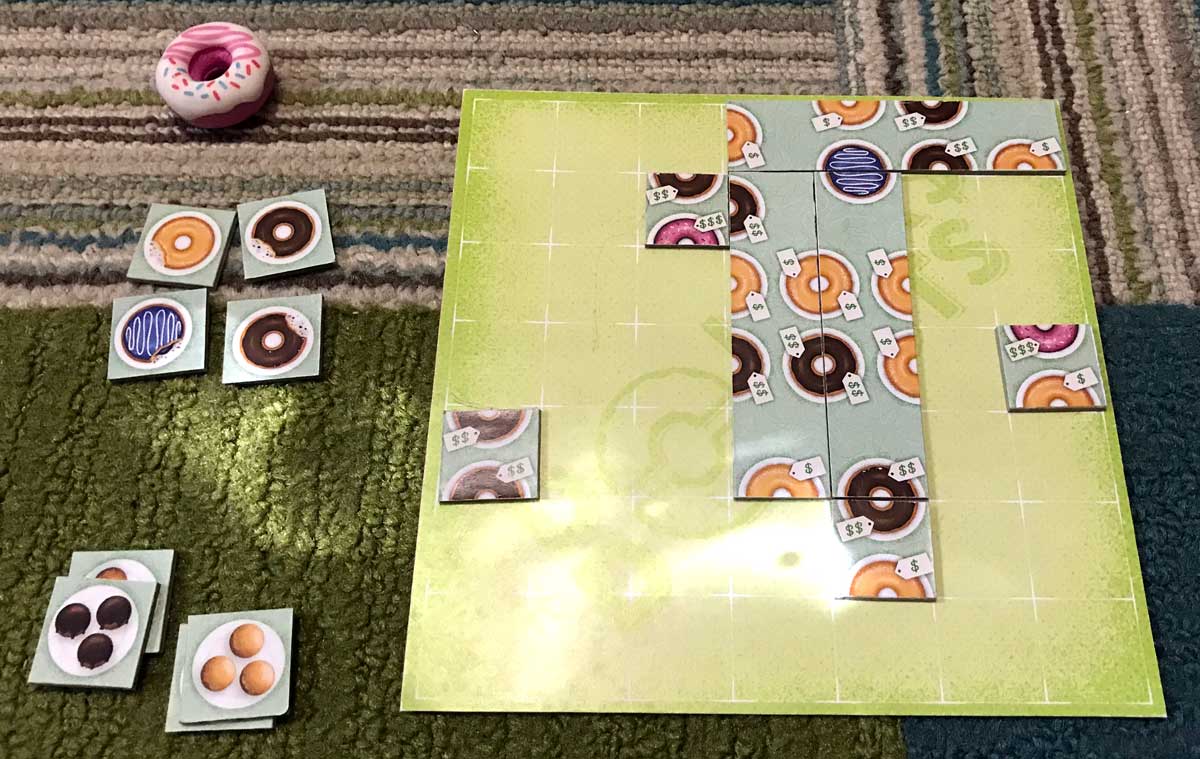
The player mat is just a 7×7 grid with a bit of color and the game logo—nothing too fancy, but it’s just the surface for your tiles. The donuts on the tiles and the point tokens are a bit more stylized than what you see on the box cover, but are easily distinguished and work well. Staring at all these donuts will definitely make you crave donuts by the time you’re done!
How to Play Dollars to Donuts
You can download a copy of the rulebook here. You can also try out the game on Tabletopia or Tabletop Simulator.
The Goal
The goal of the game is to score the most points by making completing donuts and satisfying customers. Oddly enough, making money is not the object of the game, though it does serve as a tie-breaker.
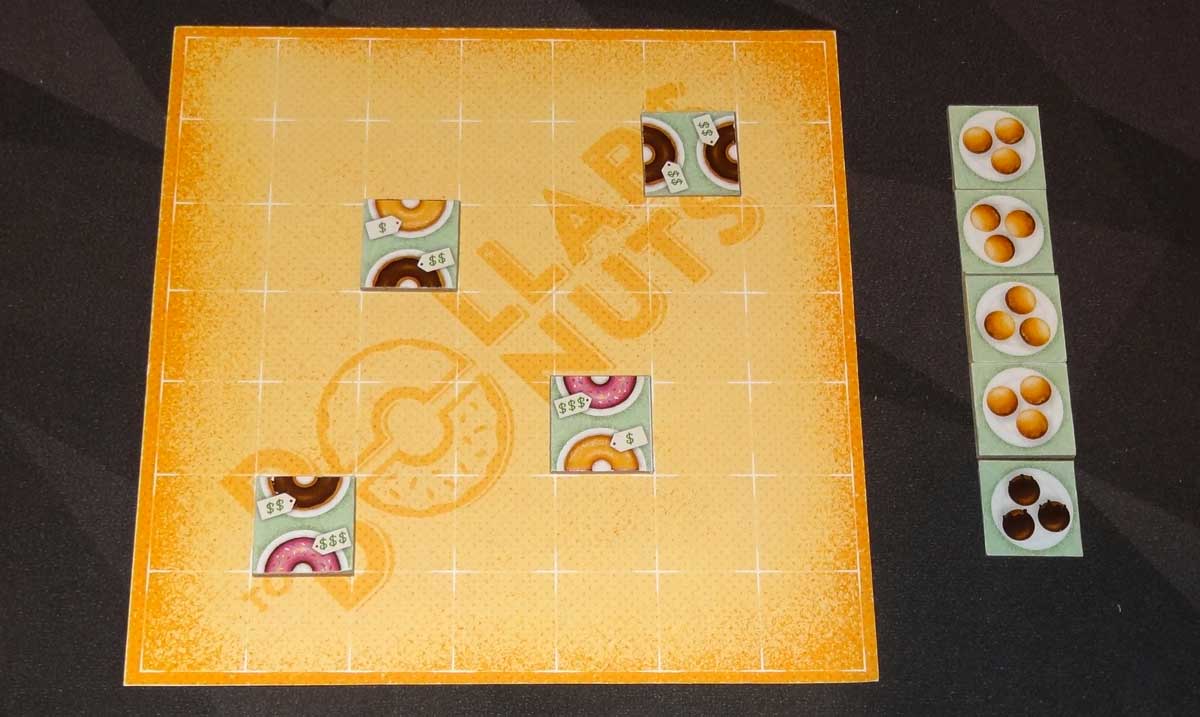
Setup
Give each player a player mat and the four starting tiles of matching color, as well as 5 dollar tiles. (The dollar tiles have donuts on the back: each player should have 4 plain donut holes and 1 chocolate donut hole.) Each player must put their starting tiles onto their player mat in any orientation and position, though no two tiles may be in the same column or row.

Place the specials board in the center of the play area, with the point tokens below it. Shuffle the donut tiles and make a supply to the left of the board, and then fill in the specials board with 6 donut tiles. Shuffle the customer cards and make a row of 4 face-up customers. Place the dollar tokens into the bag and set it nearby.
The player who most recently ate a donut or visited a donut shop is the first player.
Gameplay
On your turn, you do the following:
- Buy and place a donut tile
- Collect points and money
- Place a dollar tile (optional)
- Serve a customer (optional)
- Refill
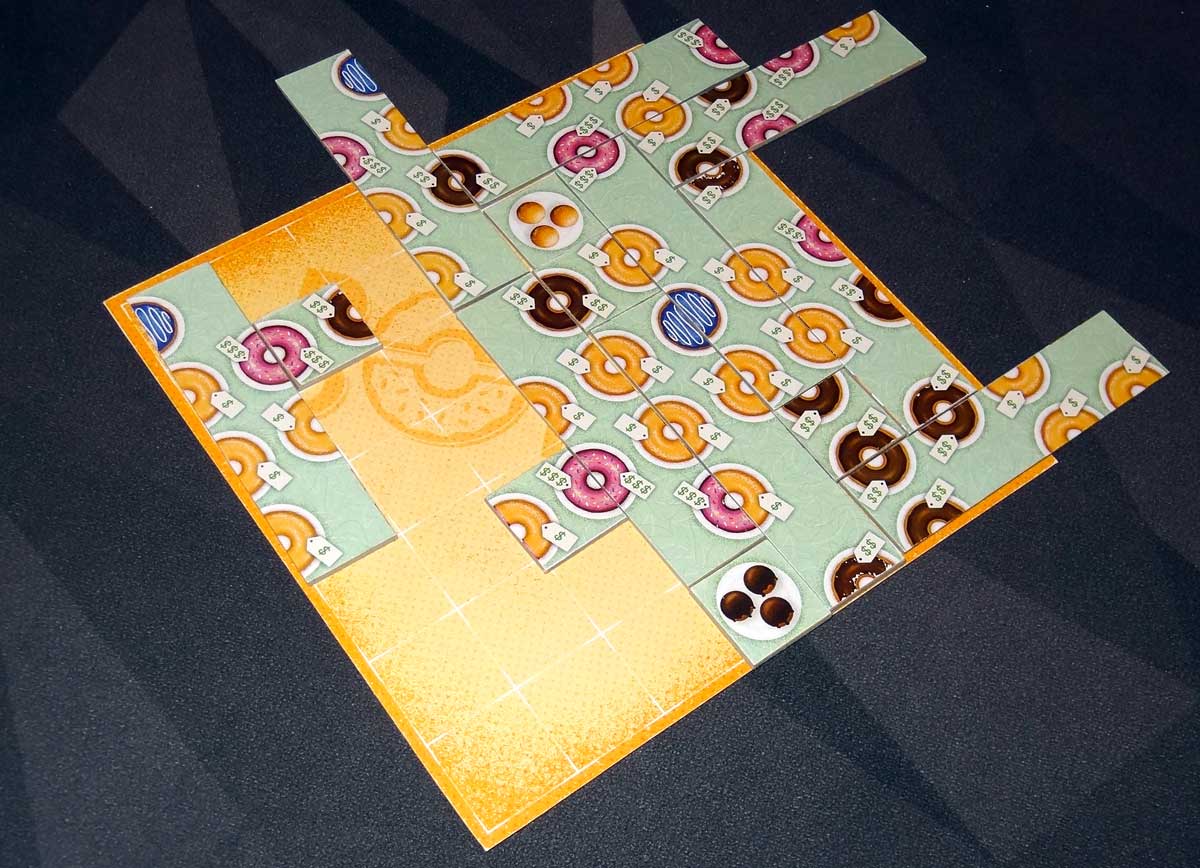
Buy and place: The first thing you always do is buy a donut tile from the specials board and place it on your mat. The donut tiles have prices below them on the board, which you pay with your dollar tokens by putting them back into the cloth bag. Tiles can go in any orientation, and can even hang off the edge of your mat, though you don’t get any effects from anything outside the boundaries of your mat.
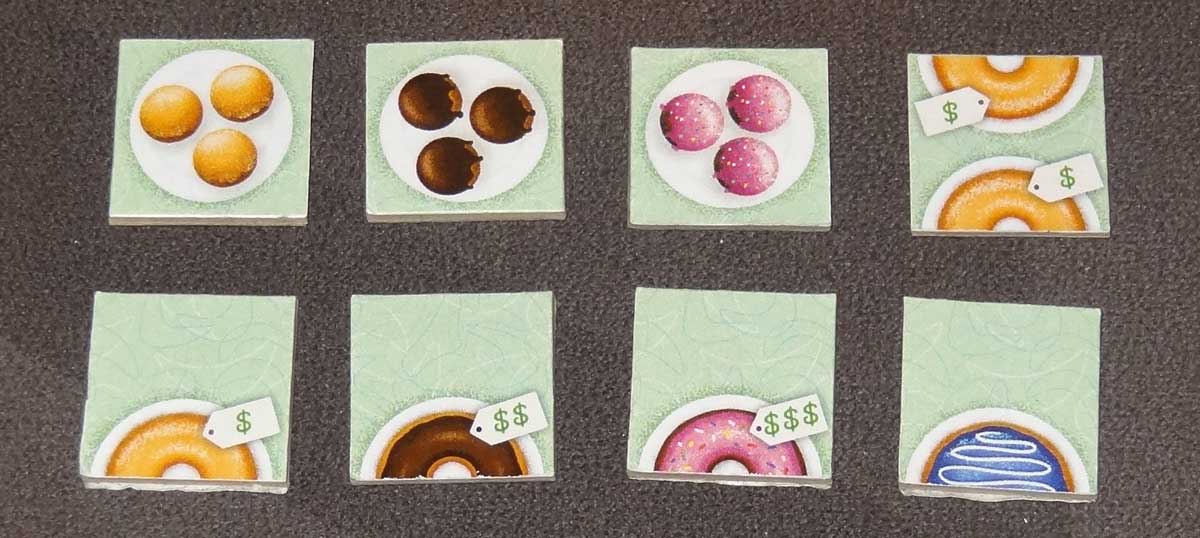
Collect: For each matching donut you’ve created with your tile, you take the corresponding victory token. For each mismatched donut you created, you collect dollar tiles (from the bag) equal to the higher of the two dollar signs on the two donut halves. Note that mismatched jelly donuts do not earn money, no matter what the other half is.
Place a dollar tile: You may optionally place one dollar tile onto your mat. Some dollar tiles have donut halves on the back that can make more donuts (or dollars); others have donut holes, which may be worth points at the end of the game if you have matching pairs.
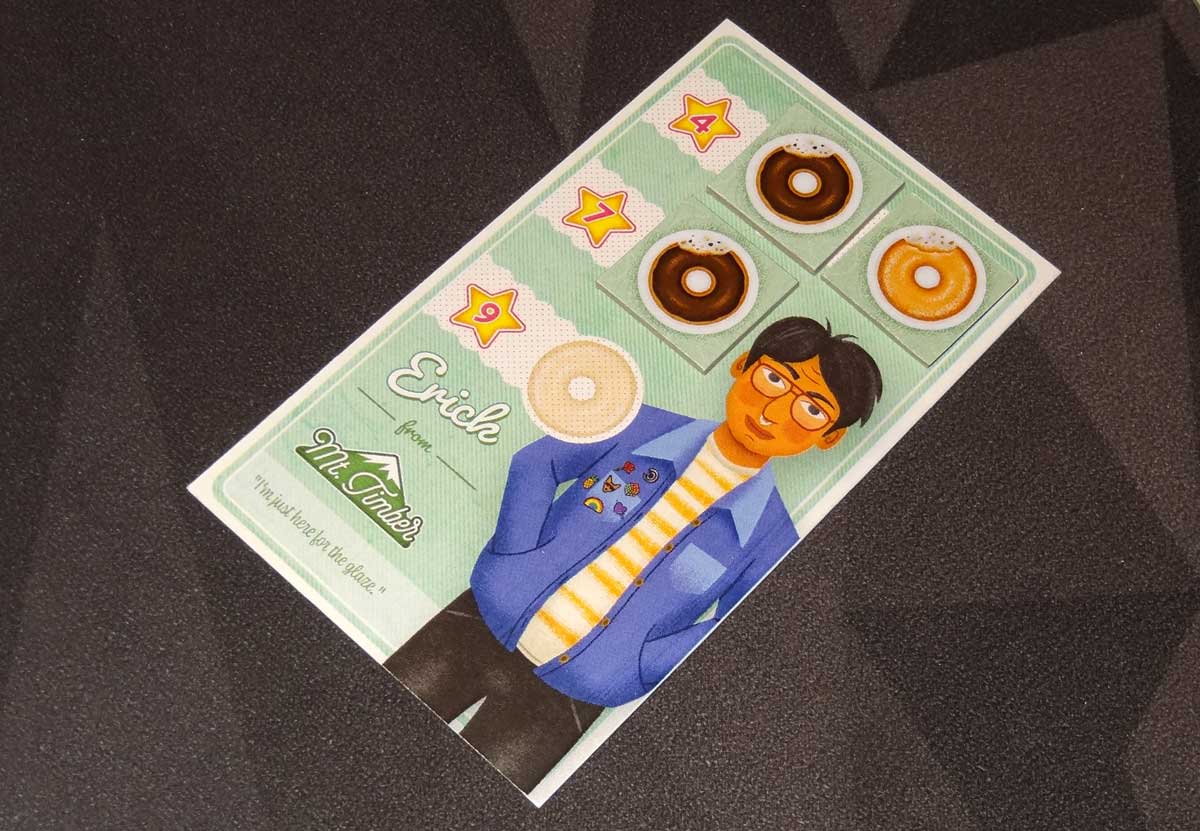
Serve a customer: If you have the right donuts, you may serve one customer. Each customer has three lines of donuts, and you must fill the lines from top to bottom. You may only serve a customer if you can complete at least one line, and once you’ve served them, you cannot give them any more donuts later. Take the customer card and place it near your mat, and place any donuts you’re serving them onto the customer cards in the indicated spaces.
Refill: Slide the donut tiles on the specials board to the right to fill in any gaps, and draw a new donut tile to refill the board. If you served a customer, draw a new customer card to refill the row.

Game End
If a player fills in their mat completely without any holes, then finish the round (so all players have had the same number of turns) and then the game ends.
If there are not enough donut tiles to refill the specials board at the end of a player’s turn, the game ends immediately.
You earn points for the following:
- Served customers
- Neighborhood bonuses:
- 3 points for each set of all 3 neighborhoods served
- 2 points for each neighborhood that you’ve served the most
- Pairs of matching donut holes on your mat (plain: 1 point, chocolate: 2 points, sprinkled: 3 points)
- Victory tokens not served to customers
- -1 point for each empty space left on your mat.
The highest score wins, with ties going to the player with the most dollar tiles left, and then the player with the fewest empty spaces.

Why You Should Play Dollars to Donuts
I’ve been on a bit of a puzzle-game kick lately: several of the games I’ve played and written up (like Overworld or The Whatnot Cabinet) have featured some type of spatial puzzle, where you’re trying to find the best piece for your layout and then figure out the best place to put it. Dollars to Donuts is another great example of a game that can give your spatial reasoning a good workout.
Although “take one tile and place it on your board” is a simple enough instruction, there’s actually a lot going on there. There are six tiles to choose from (though realistically who wants to spend $5 on a donut tile?), and well over a hundred ways that a tile could be placed (at least before it starts filling up), since the tiles can hang off the edge of your mat. Things you’ll need to consider: do you have enough money for the tile you want? Are you trying to make matching donuts (for points and customers) or non-matching donuts (for dollars)? Even the decision to spend some money can be difficult: which dollar tokens do you spend and which do you save to place onto your mat?
The dollar tokens are a tricky factor. You can only place one on your mat per turn, and they can be invaluable for completing that one donut that you boxed in accidentally, or earning some points for those dead spaces on your board. But it also helps to keep a few on hand in case a tile comes up that you really want—not having any money means you just get whatever the free donut tile is on your turn. Unplaced dollar tokens aren’t worth anything at the end of the game, though, so if you end up with a pile of money, it generally means you didn’t play very efficiently.
The competition for customers can be fierce, and it pays to keep an eye on what donuts other people have already made. Sure, you could get more points for the customer if you wait until you had more donuts, but you might not get that opportunity. Maybe it’s better to just tempt the customer with two donuts (the minimum) before your rival gets a chance!
Each customer is worth 1 extra point for each line that you fill: for instance, if a customer wants a plain (1 point) and a chocolate (2 points), then serving those two donuts will be worth 4 points. Filling all three rows will net you 3 points over the value of those donuts. That may not seem like a huge amount, but the other factor is the neighborhood bonuses. You’ll want to collect sets of all three neighborhoods for bonus points, and you also get bonus points for dominating the market in any given neighborhood. That 1 extra point for barely serving a customer could actually be even more if that customer completes a set and gives you the majority.

I suppose theoretically there could be hate-drafting in Dollars to Donuts, where you take a donut tile not because you want it, but because you think it could be useful to another player. I’m certainly not experienced enough yet for that: on my turns, I’m generally just trying to find a tile that will fit my board, without trying to consider the many potential ways other players could use any given tile. We may be competing donut shops, but we’re not actively sabotaging each other … yet. For now, we’re content to race each other for customers.
There is a bit of weirdness thematically. Why do you get money for making mismatched donuts but not from serving customers? Who makes donuts by assembling trays of half donuts anyway? Why are dollar bills also equivalent to half donuts and donut holes? I don’t know if Dollars to Donuts started off as something else entirely and got the donut theme later, or if it was always about donuts, but the theme doesn’t necessarily line up with the gameplay in a way that makes sense. That’s okay with me, but if you really like your games to be immersive, you might feel a disconnect here.
I should also note that Dollars to Donuts may not be great for people who want everything to fit nicely. Unlike a jigsaw puzzle or solving a sudoku puzzle, there may not be a single optimal solution for your player mat. Each donut tile is 4 squares long, and has 6 half-donuts on them, sometimes even on the ends. You might find the perfect piece that drops into an opening and completes all 6 donuts, but I’ve never seen it happen. Even getting 3 donuts to line up can be impossible at times, and it’s inevitable that at some point you’ll find yourself with two donut halves meeting at a right angle, knowing that completing one will block the other. My teenage daughter, who wants everything to fit exactly into its place, had a hard time with Dollars to Donuts because of this—not to mention the bits of tiles hanging off the edge of the mat!
Speaking of which, that’s one of the features that makes Dollars to Donuts unique. I can’t think of many tile-laying games that allow the piece to overhang the border. In Dollars to Donuts, that opens up a lot more possibilities for placing a tile, and can be really useful—but it’s also inefficient, because it means you’re throwing away some number of donut halves that don’t count toward anything. You lose points at the end of the game for any empty spaces on your mat, so if somebody is keeping all of their tiles within their mat, they’ll fill up their mat more quickly, and that could end up costing you points if you’ve got a lot of tiles hanging off the sides.
I’ve really enjoyed playing Dollars to Donuts. I was able to play the physical prototype with my kids, and I was given access to a digital version in Tabletop Simulator to play with some of my gaming group. It’s a clever game that gets my gears turning and makes me hungry for donuts. (Though I would never serve chocolate glazed donuts at my game table, the way they do in the Kickstarter video!) If you enjoy spatial puzzles and tile-laying games, or you just like donuts, it’s worth checking out.
For more information or to make a pledge, visit the Dollars to Donuts Kickstarter page!
Click here to see all our tabletop game reviews.
![]() To subscribe to GeekDad’s tabletop gaming coverage, please copy this link and add it to your RSS reader.
To subscribe to GeekDad’s tabletop gaming coverage, please copy this link and add it to your RSS reader.
Disclosure: GeekDad received a prototype of this game for review purposes.
